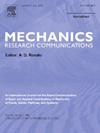Effect of auxetic behavior on effective properties of composite materials
IF 2.3
4区 工程技术
Q3 MECHANICS
引用次数: 0
Abstract
In this paper, a two–phase composite material consisting of negative Poisson's ratio elastic material is considered. The effective elastic properties (bulk modulus, shear modulus and Poisson's ratio) of two–dimensional heterogeneous materials are estimated by the finite element numerical homogenization technique. To this end, three constructs were used to investigate the effect of auxetic behavior on effective properties. The matrix of the first structure has auxetic behavior, Negative Poisson's Ratio NPR, the circular inclusions are elastic with Positive Poisson's Ratio PPR. The inclusions of another structure are circular auxetic material, the matrix is elastic material. The last case is that both matrix and inclusions possess auxetic property. And taking into account five different volume fractions from each case. The concept of Representative Volume Element RVE is introduced, in which the homogenization numerical simulation based on finite element is carried out. The effectiveness of numerical calculation is verified by applying two boundary, periodic boundary conditions and kinematic uniform boundary conditions. We demonstrate that by mixing auxetic and non–auxetic phases into composites, it is possible to preserve some of the unique properties of auxetic materials while enhancing the unique properties of traditional single–phase materials. The strengthening effect is controlled by Poisson's ratio of each phase, elastic modulus, and shape of inclusions. Studying the strengthening effect of composite auxetic materials can provide a reference for designing composite materials with new properties.
消长行为对复合材料有效性能的影响
本文研究了一种由负泊松比弹性材料组成的两相复合材料。采用有限元数值均质化技术对二维非均质材料的有效弹性特性(体积模量、剪切模量和泊松比)进行了估计。为此,我们使用了三个构念来研究消声行为对有效性能的影响。第一种结构的基体具有惰性,负泊松比为NPR,圆形夹杂物具有弹性,正泊松比为PPR。另一种结构的内含物为圆形的辅助材料,基体为弹性材料。最后一种情况是基体和夹杂体都具有生长性。考虑到每种情况下的五种不同的体积分数。引入了代表性体积单元RVE的概念,并对其进行了基于有限元的均匀化数值模拟。采用周期边界条件和运动均匀边界条件验证了数值计算的有效性。我们证明,通过在复合材料中混合生长相和非生长相,可以在增强传统单相材料的独特性能的同时保留生长相材料的一些独特性能。强化效果受各相泊松比、弹性模量和夹杂物形状的控制。研究复合增氧材料的强化效果可以为设计具有新性能的复合材料提供参考。
本文章由计算机程序翻译,如有差异,请以英文原文为准。
求助全文
约1分钟内获得全文
求助全文
来源期刊
CiteScore
4.10
自引率
4.20%
发文量
114
审稿时长
9 months
期刊介绍:
Mechanics Research Communications publishes, as rapidly as possible, peer-reviewed manuscripts of high standards but restricted length. It aims to provide:
• a fast means of communication
• an exchange of ideas among workers in mechanics
• an effective method of bringing new results quickly to the public
• an informal vehicle for the discussion
• of ideas that may still be in the formative stages
The field of Mechanics will be understood to encompass the behavior of continua, fluids, solids, particles and their mixtures. Submissions must contain a strong, novel contribution to the field of mechanics, and ideally should be focused on current issues in the field involving theoretical, experimental and/or applied research, preferably within the broad expertise encompassed by the Board of Associate Editors. Deviations from these areas should be discussed in advance with the Editor-in-Chief.

 求助内容:
求助内容: 应助结果提醒方式:
应助结果提醒方式:


